Workshops
by Michael Frye | Aug 15, 2012 | Announcements, Workshops
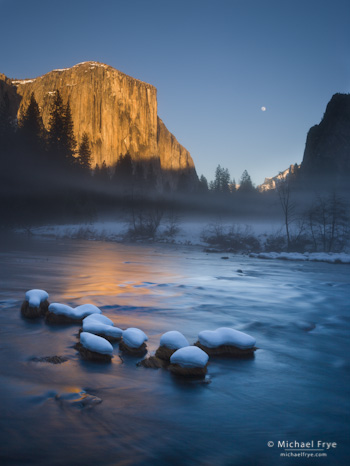
A January moonrise from Valley View, Yosemite
The Ansel Adams Gallery recently announced their 2013 workshops. I’m pleased to be teaching four Yosemite photography workshops for the Gallery next year—Landscapes in the Digital Darkroom: Mastering Lightroom (January); Spring Yosemite Digital Camera Workshop (April); Hidden Yosemite (July); and The Digital Landscape: Autumn in Yosemite (October).
As many of you know, I’m a big fan of Lightroom because it’s simple, yet powerful—easy to use, but sophisticated enough to get great results with almost any image. Last January was the first time I taught a workshop specifically focused on this tool: Landscapes in the Digital Darkroom: Mastering Lightroom. This class was popular, and a lot of fun, so we’ll be doing it again next January. Of course it’s not all computer work—the workshop includes field sessions to photograph snowy January landscapes, the rising full moon, and, if we’re lucky, clearing storms. I’m really looking forward to it!
The other three workshops—Spring Yosemite Digital Camera Workshop, Hidden Yosemite, and The Digital Landscape—have been very popular in the past, and sometimes fill quickly, so be sure to reserve space early.
And stay tuned… I’ll be announcing more workshops within the next month.
(more…)
by Michael Frye | Jul 26, 2012 | Workshops
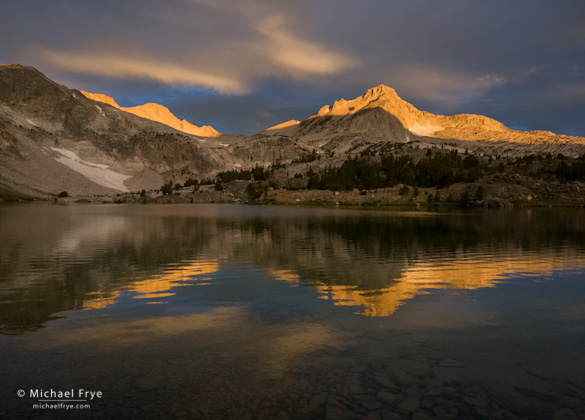
Sunrise illuminates North Peak. I like the rippled reflection, preserved by a fast shutter speed (1/90th sec).
Teaching my Hidden Yosemite workshop last week was so much fun. We had some wonderful clouds to make the skies more interesting, and a great group of people, plus it’s always fun to get away from the roads and into some beautiful areas that you just can’t drive to.
Weather forecasts before the workshop called for clear skies, but our first evening we photographed some amazing lenticular clouds, including two UFO disks over Mammoth Peak, and another formation to the north resembling an Imperial Star Destroyer. Later in the week the sun broke through overcast skies just before sunset and lit up the clouds over Gaylor Lakes, and the next morning we watched sunlight poke through more clouds to illuminate North Peak. And then it snowed. Meteorologists try to predict the future, which is a difficult job. This is one time when I’m glad they were wrong—the clouds definitely made things more interesting.
(more…)
by Michael Frye | Jun 26, 2012 | Vision and Creativity, Workshops
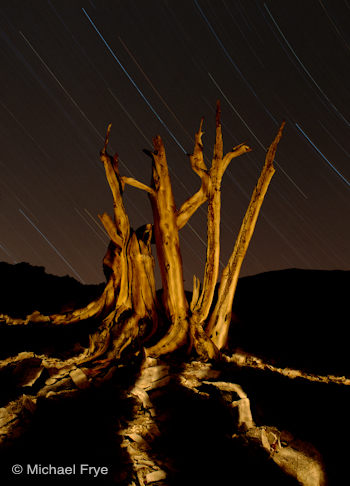
Bristlecone pine snag at night with star trails, White Mountains
Night photography offers wonderful opportunities to be creative. The low light allows you to use long exposures to record movement, like star trails or moonlit clouds. And since the natural light is so dim, you can easily overpower it with a flash or flashlight and add your own light to a scene.
That aspect of night photography—light-painting—has intrigued me for a long time. Adding your own light to a nighttime scene gives it a new dimension; it instantly transforms the landscape into something different, something we never see in real life, and adds a mysterious, surreal element to the photograph.
The accompanying image has both movement, in the form of star trails, and light-painting. I used a flashlight to trace the branches of this bristlecone pine snag, then painted zig-zag lines over the rocky foreground. I made this photograph with medium-format film back in September of 2000. Some test exposures with a Polaroid back helped me get the light-painting right, then I switched to real film (probably Provia), did the light-painting again, and then left the shutter open for another 90 minutes to record the star trails. You can see more examples of my light-painting techniques in my nighttime portfolio.
I learned light-painting with film, which was a slow trial-and-error (mostly error) process. Digital cameras make the learning curve much easier, because you can experiment and see the results immediately. If you’ve never tried night photography before this might be a fun summertime project—a way to stretch yourself a little and exercise your imagination. Summer is a great season for photographing landscapes at night, since the Milky Way is prominent, and the warm nighttime temperatures make it more comfortable to stay out late.
Whether you’re an experienced night photographer or a beginner, I recommend reading Lance Keimig and Scott Martin’s excellent book Night Photography: Finding Your Way in the Dark. Also, you can find tips about focus and exposure for moonlit landscapes in my post about photographing lunar rainbows.
And if you prefer hands-on learning there’s still space in my Full Moon Night Photography workshop later this summer (July 31st and August 1st). This is a great way to get personalized instruction and learn night photography in a fun, supportive group atmosphere. Rooms have been set aside for this workshop in Yosemite Valley and are still available if you register soon.
—Michael Frye
Related Posts: Under the Full Moon; Tips for Photographing Lunar Rainbows; Also, see images made by participants in last year’s night photography workshop in this Flickr group
Michael Frye is a professional photographer specializing in landscapes and nature. He is the author and photographer of The Photographer’s Guide to Yosemite, Yosemite Meditations, and Digital Landscape Photography: In the Footsteps of Ansel Adams and the Great Masters, plus the eBooks Light & Land: Landscapes in the Digital Darkroom, and Exposure for Outdoor Photography. He has written numerous magazine articles on the art and technique of photography, and his images have been published in over thirty countries around the world. Michael has lived either in or near Yosemite National Park since 1983, currently residing just outside the park in Mariposa, California.
by Michael Frye | Dec 15, 2011 | Announcements, Workshops
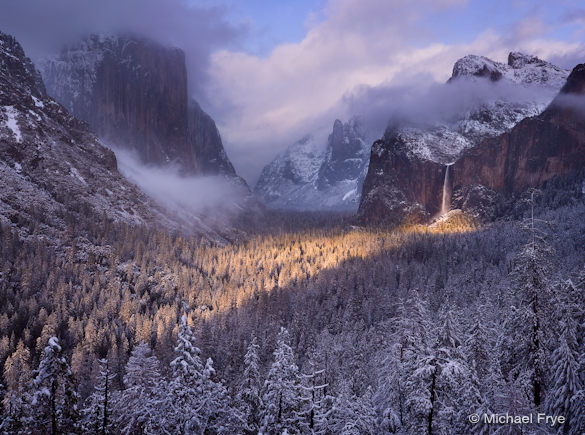
Spotlight on Bridalveil Fall
Just a quick note to let you know that, due to a cancellation, there’s one space available in my Landscapes in the Digital Darkroom: Mastering Lightroom workshop, January 16-20, 2012. And since it’s in January, it should be no problem to get a hotel room this late—and at off-season rates! Click here to register and grab that last space.
Meanwhile, my Spring Digital Camera workshop is full, and the Eastern Sierra Fall Color workshop filled within a few days. But there’s still space left in the Hidden Yosemite (July), Full Moon Night Photography (July-August), and Digital Landscape (October) workshops.
—Michael Frye
Related Posts: 2012 Workshops Announced; Two New Workshops for 2012
Michael Frye is a professional photographer specializing in landscapes and nature. He is the author and photographer of The Photographer’s Guide to Yosemite, Yosemite Meditations, and Digital Landscape Photography: In the Footsteps of Ansel Adams and the Great Masters, plus the eBook Light & Land: Landscapes in the Digital Darkroom. He has written numerous magazine articles on the art and technique of photography, and his images have been published in over thirty countries around the world. Michael has lived either in or near Yosemite National Park since 1983, currently residing just outside the park in Mariposa, California.
by Michael Frye | Dec 1, 2011 | Announcements, Workshops
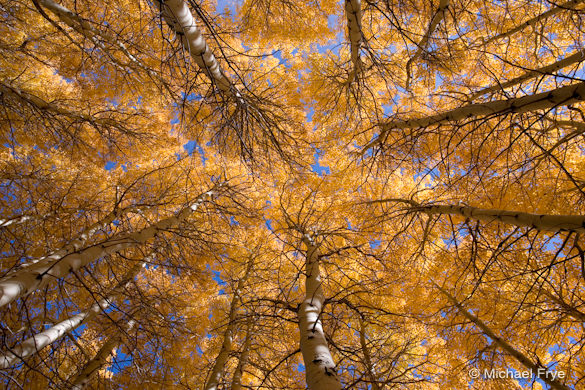
Aspen circle, June Lake Loop
Eastern Sierra Fall Color: Composition and Creativity Among the Aspens
October 18 (eve.) – 21, 2012
Is an eye for composition something you’re born with, or can it be taught—and learned?
The technical aspects of photography are pretty concrete. With a little instruction anyone can learn to read a histogram or control depth of field. But composition, creativity, and seeing are more nebulous. The infinitely varied world we photograph doesn’t lend itself easily to compositional rules and formulas. There’s a reason no one has yet developed an app that tells you when you’ve framed a good photograph!
I used to think an eye for composition was innate, but over the years I’ve changed my mind. I’ve seen my own compositional skills improve with time, but more importantly, I’ve watched many students—even some who thought they lacked that innate ability to “see”—grow and develop their sense of design, sometimes in great leaps. Composition can be taught, and learned by anyone. And no matter how long you’ve been making photographs you can always learn more.
(more…)
by Michael Frye | Nov 28, 2011 | Workshops
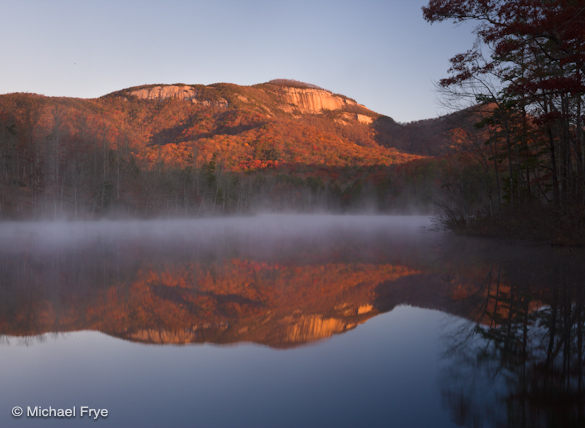
Table Rock at sunrise
To those who celebrate Thanksgiving, I hope you had a great holiday. And if you don’t celebrate Thanksgiving, I hope you had a good weekend anyway!
The week before Thanksgiving I flew to South Carolina. A couple of people who had previously taken my Spring Digital Camera Workshop got some of their friends together and invited me to come to their home and teach a workshop.
I’d never been to this part of the country before, and found it to be quite beautiful. This region, in the mountains along the border between North Carolina and South Carolina, is home to a great concentration of waterfalls. Of course I live near another great waterfall area, Yosemite, but the character of the falls is quite different in each place. Yosemite is known for its big, thundering, dramatic, vertical drops like Yosemite Falls and Bridalveil Fall. The Carolina waterfalls are smaller, and usually slide down less-than-vertical rock faces, but they have braids and channels that lend themselves to slow shutter speeds and more intimate compositions, and in their own way they’re equally photogenic.
(more…)














